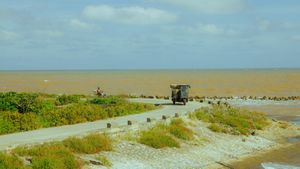Wildlife conservation is not only about protecting animals; it’s about preserving entire ecosystems and the cultural heritage intertwined with these natural environments. Recent initiatives show how funding is being allocated to tribes and organizations working hard to sustain wildlife and restore habitats. The U.S. Fish and Wildlife Service (FWS) has granted over $6.4 million to 35 Native American and Alaskan Native tribes for conservation efforts across 15 states. This initiative emphasizes the importance of collaboration and respect for indigenous knowledge and stewardship over their traditional lands.
According to Service Director Martha Williams, collaboration with federally recognized tribes is pivotal for meaningful conservation. “Knowledge sharing, co-stewardship, and strong relationships with Federally recognized Tribes are key to conservation,” Williams said. The funding received by these tribes is not only aimed at environmental conservation but also at building the capacity for natural resource management within these communities. This year marks the first time funding has been distributed to seven of these tribes, introducing them to the Tribal Wildlife Grants program, which has awarded more than $124.5 million since its inception in 2003.
The Biden-Harris administration is pushing forward with initiatives like “America the Beautiful,” which is focused on locally led, voluntary conservation efforts. This includes considering the priorities of Tribal nations when making decisions about land management and resource conservation. Their significant land stewardship reflects the deep connection between tribes and their environments, with over 100 million acres of habitat under the influence or management of 574 federally recognized tribes.
Notable projects funded this year include innovative uses of technology. The Sitka Tribe of Alaska, for example, has received funding for the implementation of artificial intelligence to monitor sockeye salmon populations. A $200,000 grant will enable real-time automated video counts at Redoubt Lake, significantly reducing costs associated with traditional monitoring methods.
Another key recipient is the Navajo Nation, which received $100,000 to study its black bear population and preserve traditional ecological knowledge alongside minimizing human-bear conflicts. This kind of project highlights the importance of integrating scientific research with indigenous practices, maintaining the balance between wildlife needs and community values.
The world of wildlife conservation isn't limited to U.S. boundaries or indigenous practices. Across the globe, initiatives are taking shape, often powered by nonprofit organizations actively engaged in protecting marine wildlife. A prime example is the efforts to promote sustainable seafood consumption, spearheaded by advocacy groups like Oceana. They have been at the forefront of campaigns aimed at educating consumers about the impacts of overfishing and habitat destruction.
Oceana’s comprehensive initiatives focus on restoring wild fish populations to serve as sustainable protein sources for communities worldwide. Their campaign, “Save the Oceans, Feed the World,” highlights the possible revivals of fish stocks through responsible fishing practices. This campaign not only seeks to maintain the integrity of marine ecosystems but also addresses food security issues exacerbated by unsustainable fishing practices.
A noteworthy shifting perspective within wildlife conservation was brought to light through the lens of ocean photographer Álvaro Herrero. Herrero, who has spent nearly two decades immersed under the sea, captures the beauty of marine life and the interwoven challenges faced by these species. His experiences filming whales showcase their sentience, bringing emotional depth to the work of conservation through photography. He poignantly expressed the struggles of marine life, particularly when recounting his encounter with a dying humpback whale off the Baja California coast.
Herrero’s photographs serve as stark reminders of the harsh realities facing marine wildlife. His commitment to publishing images like his emotionally charged piece entitled “Hopeless,” aims to evoke awareness about the plight of marine species caught up in human activities such as fishing. The heartbreaking dichotomy of capturing beauty yet highlighting destruction embodies the complex relationship humans have with wildlife. His message is clear; it’s upon us to reflect on our actions and advocate for the conservation of nature’s treasures before they are irrevocably lost.
Meanwhile, the Kadoorie Farm and Botanic Garden in Hong Kong exemplifies dedicated wildlife rehabilitation efforts. Recently, they celebrated the successful release of a black kite, which had been rescued and cared for after sustaining injuries. The farm’s staff, led by rehabilitation officer Bibi Wan, monitored the bird's recovery closely, ensuring it regained the strength needed to return to the wild.
These diverse conservation stories converge around one central theme: wildlife is facing unprecedented challenges, and collaborative efforts are imperative for survival. From local tribes receiving federal grants to international organizations pushing back against overexploitation of resources, the message is clear – we must work together.
Efforts like these suggest there is still hope for balance between human activity and the natural world. It’s not just about saving animals; it's about building ecosystems and careers focused on sustainability through education and community involvement.
While we celebrate these victories, the work is far from done. Continued awareness, funding, and community involvement are necessary for ensuring wildlife conservation efforts flourish both locally and globally. Our ecosystems rely on the diversity of wildlife, and as such, we all have roles to play. Making informed choices as consumers, supporting conservation initiatives, and advocating for policies favoring sustainability are steps everyone can take. The future of our planet, and the species within it, may very well depend on these collective actions.



